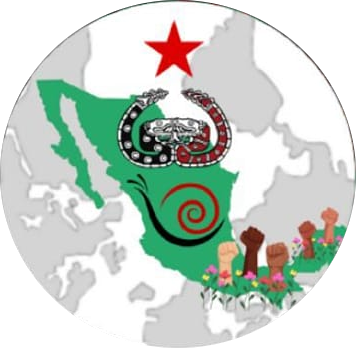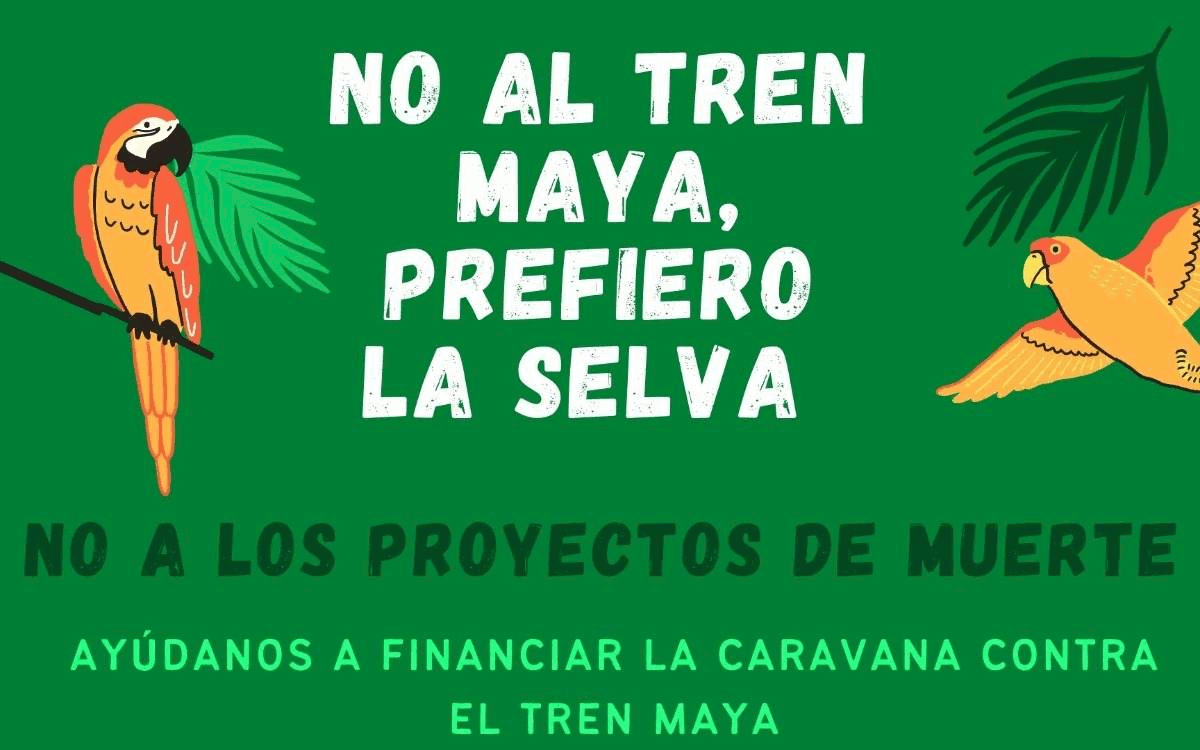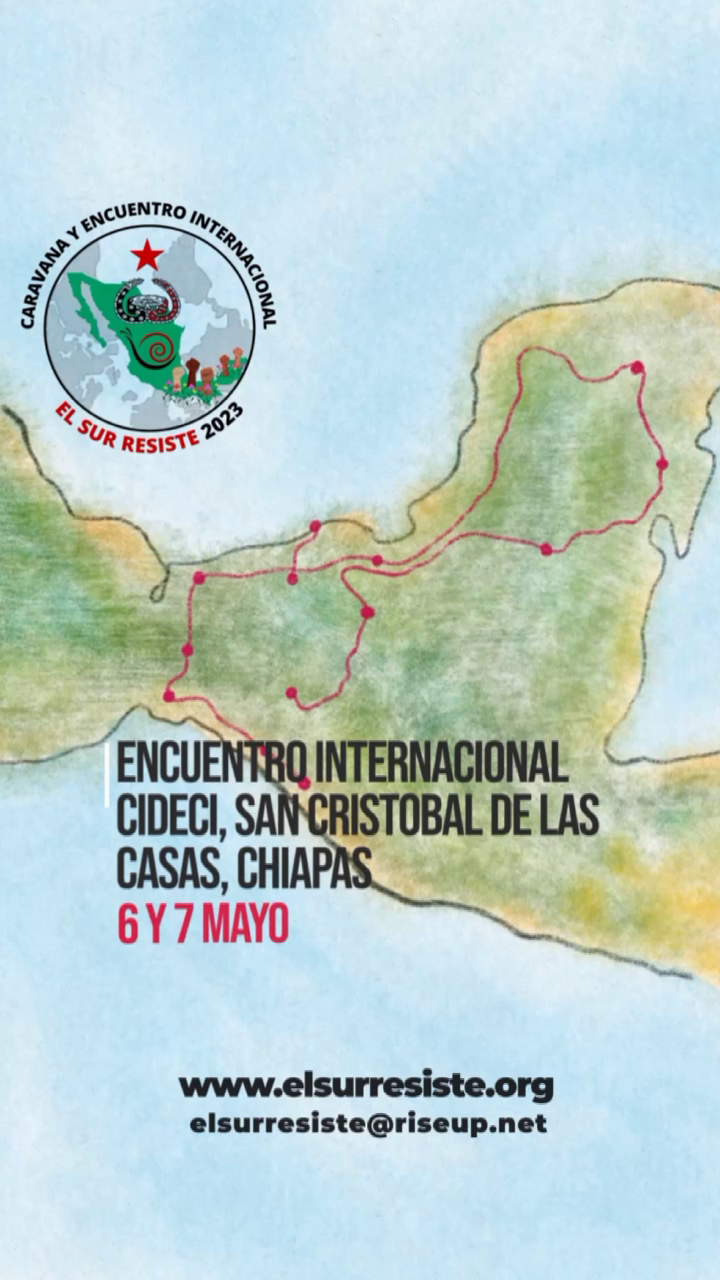
The night of April 25, the Caravan El Sur Resiste arrived in Puente Madera, Oaxaca. There it met the community that resists the construction of a monstrous Industrial Park, part of the Interoceanic Railroad project, also known as the Interoceanic Corridor.
The reception by the community was in a fighting spirit. A long line of people carrying torches greeted the caravan at the intersection of the highway where they have maintained sit-ins and blockades for weeks, demanding to be heard. Members of the Caravan disembarked to join the members of the community, beginning a march into town, escorted by a train of motorcyclists, cars, and moto-taxis. The night was filled with cries of ¡Puente Madera No Se Vende! (Puente Madera is not for sale!), El Istmo no se vende! (The Isthmus is not for sale!) and the sound of horns and fireworks exploding overhead.
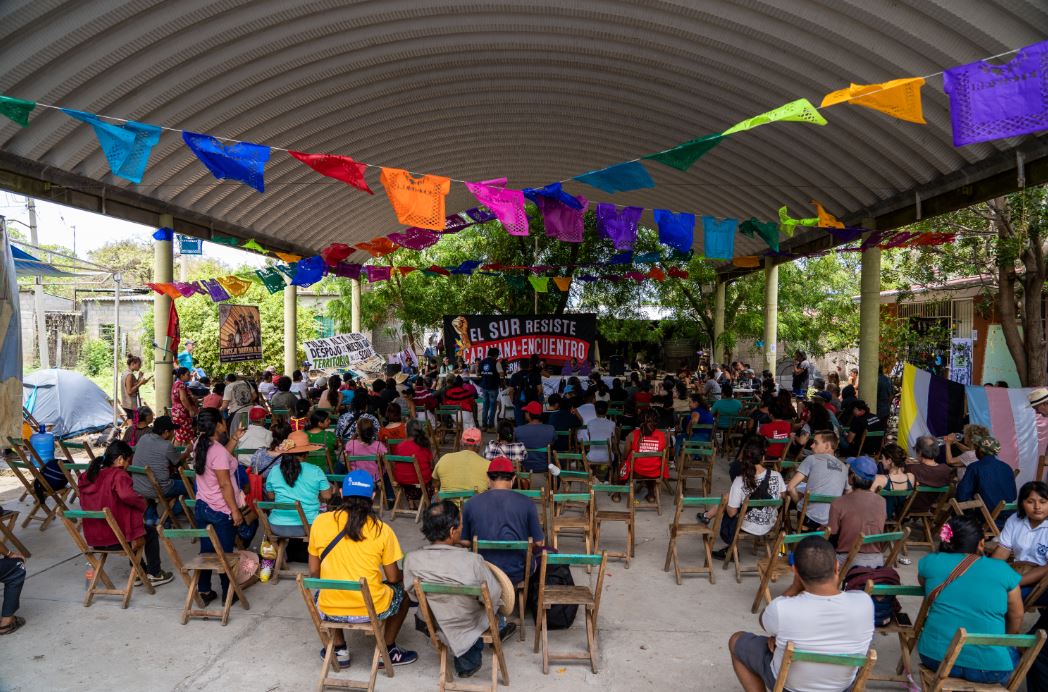
The Pitayal
On the second day of the Caravan, Wednesday, April 26th, members of the Caravan visited the Pitayal, an area full of mesquites, coyotes, rabbits, deer, and other plant and animal species. All of this ecosystem is in danger of being converted into part of the Industrial Park, one of seven parks being promoted by the Federal Government.
There, members of the community of Puente Madera explained what is at risk of being built. All agree on an extremely important point: the Pitayal represents more than just a physical space and the biodiversity that inhabits it. Its existence is also the basis of the very existence of the community of Puente Madera, as explained by a woman from the community:
“From the Pitayal we live, we eat. From there we eat because we cut wood that we use for cooking but that we also sell, and there are rabbits and deer. If they take away the Pitayal, it is as if they took away the bank account we live on.”
This is an aspect that the government of Andrés Manuel López Obrador has decided to ignore about the Original Peoples who inhabit the territory called Mexico, along with the other neoliberal governments that have preceded it. The territory represents more than a physical entity and resources that they can obtain from it; Original peoples, such as the Zapotecs of Puente Madera, have developed their way of life in complete connection with their natural environment.
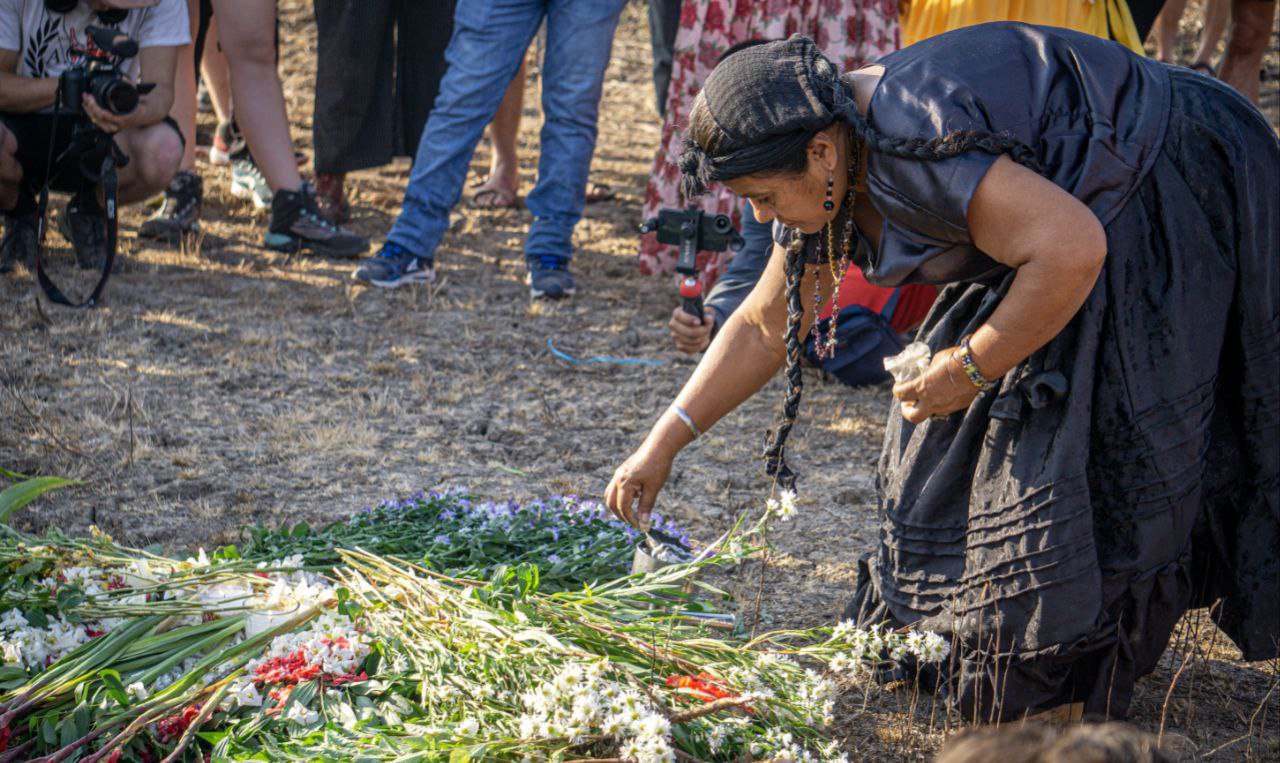
If the territory in which a community lives is destroyed, not only its physical environment is destroyed. The way of life of an entire people is threatened; their food, their ways of producing economic resources, their culture, tradition, and way of living day to day.
The area at risk comprises more than 360 hectares, according to the community. The Government of the 4T (Fourth Transformation) has wanted to impose the project through the National Institute of Indigenous Peoples through people brought in to help win votes on public consultations, forged signatures, and threats against the community.
“We the Assembly of the Isthmus say that the current government is the worst of all. This government has not given us the slightest opportunity to tell them why we are in resistance; instead they are persecuting us.”
During the visit to the Pitayal members of the community of Puente Madera planted two different types of trees, symbols of hope that represent this particular territory. At the same time, three women made an offering in their Zapotec language. Thanking Mother Earth for sustaining life, they ask for strength to continue the struggle.
The Pitayal feels arid and dry. However, the community has a plan already in place to reforest this territory and continue their existence in harmony with it, as they have done generation after generation.
Resistances in the Isthmus of Oaxaca
After returning from the Pitayal, we joined the first panel of the forum “Rebellions and Resistances in the Oaxacan Isthmus”, in which representatives of different communities of the Isthmus region explained the problems that threaten the social, economic and environmental stability of their territories.
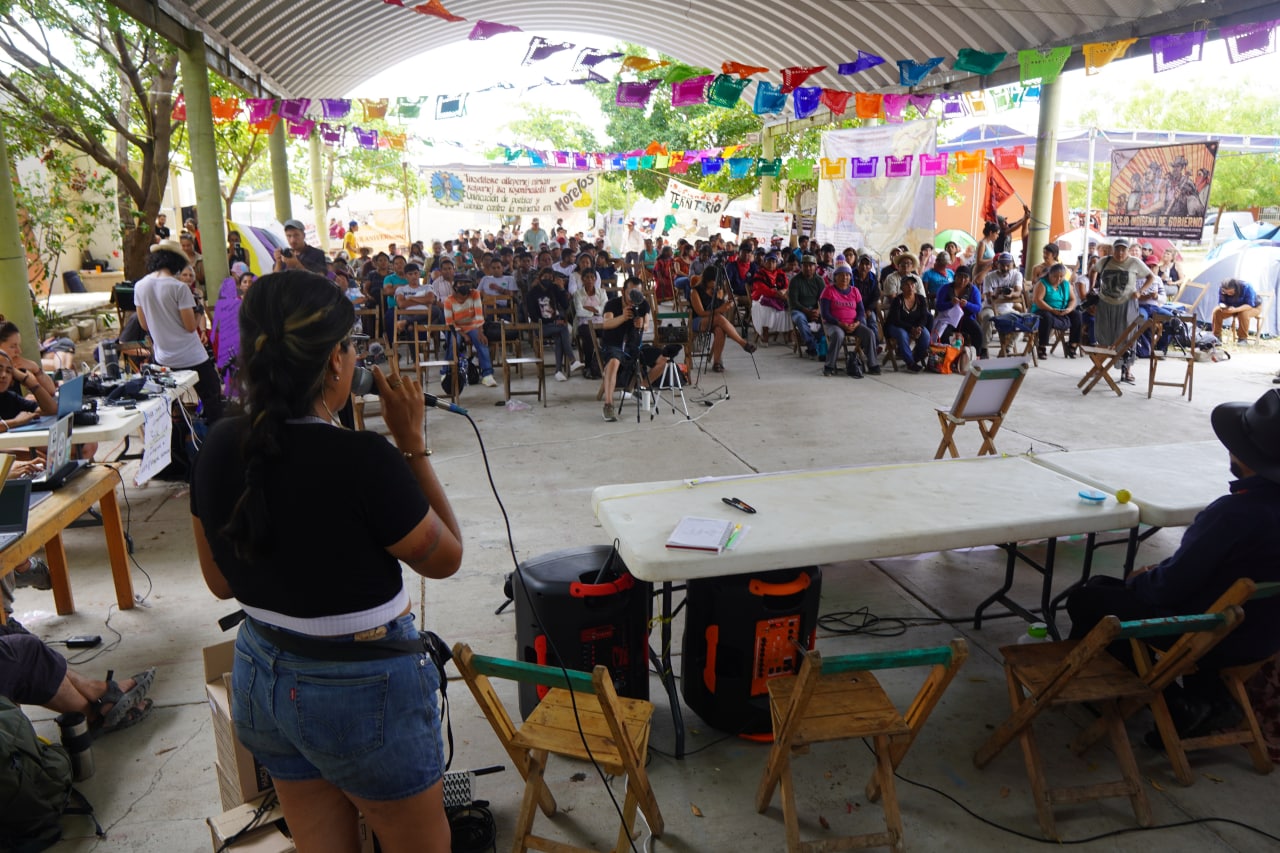
It is important to mention that it would be difficult for each community to explain the complexity of the problems they face and their forms of resistance. However, it is possible to give an overview of the region, and, as stated by each panelist, it would not be wrong to emphasize that one of the greatest threats to the peoples and communities within this region is the imposition of projects of a neoliberal nature, such as the Industrial Park in the Pitayal, which puts its existence at risk. In addition, other types of violence that are triggered by the rupture of the social fabric due to environmental and cultural destruction resulting from such imposed projects.
Among these effects could also be mentioned the forced displacement from one’s own territory, an increase in the presence of criminal groups involved in drug and human trafficking, and the increase in violence against women and girls, among others.
Next, a brief summary of the problems identified by each community present will be presented.
ASSEMBLY OF INDIGENOUS PEOPLES OF THE ISTHMUS IN DEFENSE OF LAND AND TERRITORY (APIIDTT)
The Assembly mentioned the problem of the imposition of wind farms throughout the Isthmus region, which have not generated well-being for families who were convinced to rent their lands in the legal form of usufruct, in exchange for extremely disadvantageous contracts. Wind farms, according to the APIIDT, also cause the death of pollinator species, such as bats, contribute to drought, and pollute the aquifers.
“They came to the territory, and deceived people with usufruct contracts to rent their land for 30 years. Many people did rent, but many of us fought by legal means, by direct action, by advocacy, and we were able to stop 2 projects. And although there are 15 wind farms in Juchitán, we have not received a single watt from these companies. We do not receive anything from them. These projects are not for us.”

Ixtepec: The community of Ixtepec shared part of their experience of more than 10 years of resistance against a mining project, which was never implemented due to the resistance of the people, mostly organized by women. However, they mentioned that the same situation they experienced 10 years ago, when the mining project arrived in their community, is now being experienced with the Interoceanic Corridor project.
“We were a small group of very, very young women and we were worried about everything that was happening. We were collecting data until we saw that the local leaders already had that information, but had still given the green light to exploitation by the mining company. We organized a campaign to publicize this, because we knew that what was at stake was life, and we managed to stop it.
We are now being threatened by the Interoceanic Corridor. In Ixtepec, what happened 10 years ago is happening again. People don’t know what is happening in the territory. They don’t know what an industrial park is; they don’t know that the train is going to take away whatever we have from us.”
La Ventosa: The community of La Ventosa also shared their resistance since 2016 against Canadian mining companies. They told how they managed to win the trust of community members, as well as other communities, and thus stop the project through community organization.
“The project had 30 years of concessions in force. Stopping the project has brought us defamation, threats, and fatigue, but we continue to say no to the mine; no to the wind farms. We also say no to the consultations, because they are rigged and take away our right to self-determination.”
Ixhuatán: the community of Ixhuatán explained how in the east of the Isthmus there are 16,000 hectares under concession since the six-year term of President Peña Nieto, and although the López Obrador government has denied the concession, the project to generate production zones and investment zones is known to exist throughout the Isthmus area.

The Isthmus has always been in the plans for exploitation, since the 2000’s with the Puebla Panama Plan under President Fox, the Special Economic Zones of President Peña Nieto, and President Obrador’s Interoceanic Corridor. Different names, but the same vision of exploitation.
There’s yet another mining concession, also begun under the Peña Nieto administration, on the border with the Chimalapas. It’s on the Ostuta river, the most important river in the entire Isthmus area. There is a sea of silver and copper there and they have done everything to exploit these minerals. However, it has been the defensive actions of organized communal and ejido property holders that has stopped these projects.
We also have the Sembrando Vida (Planting Life) project, which has caused people to stop working the land. Now they all plant mangoes and maguey, but now they plant only that; just mango and the land is no longer worked.”
Criminalization of the community of Puente Madera
Among the impacts that the community of Puente de Manera has borne is the persecution they have suffered for opposing the Industrial Park. Currently there are 17 arrest warrants against members of the Assembly. David Hernández Salazar was imprisoned for 8 hours, until it was proved that there were irregularities in the process, as well as the fabrication of crimes against him. However, the harassment continues, as well as the irregular judicial process.
Therefore, the Assembly of the Isthmus holds all three levels of government accountable, including Antonino Morales Toledo, Secretary of Administration of the state of Oaxaca; Salomón Jara Cruz; the governor of Oaxaca, and Andrés Manuel López Obrador, the President of Mexico, for any attack of any kind, against any member of the community, members of the Assembly or the front of Oaxacan organizations.
We join this call, demanding respect for the life and resistance of the community of Puente Madera and the entire region of the Isthmus of Oaxaca. At the same time, we demand the cancellation of the deadly projects in this region that represent a threat to the life and existence of the communities that have inhabited these territories for centuries, protecting Mother Earth.
